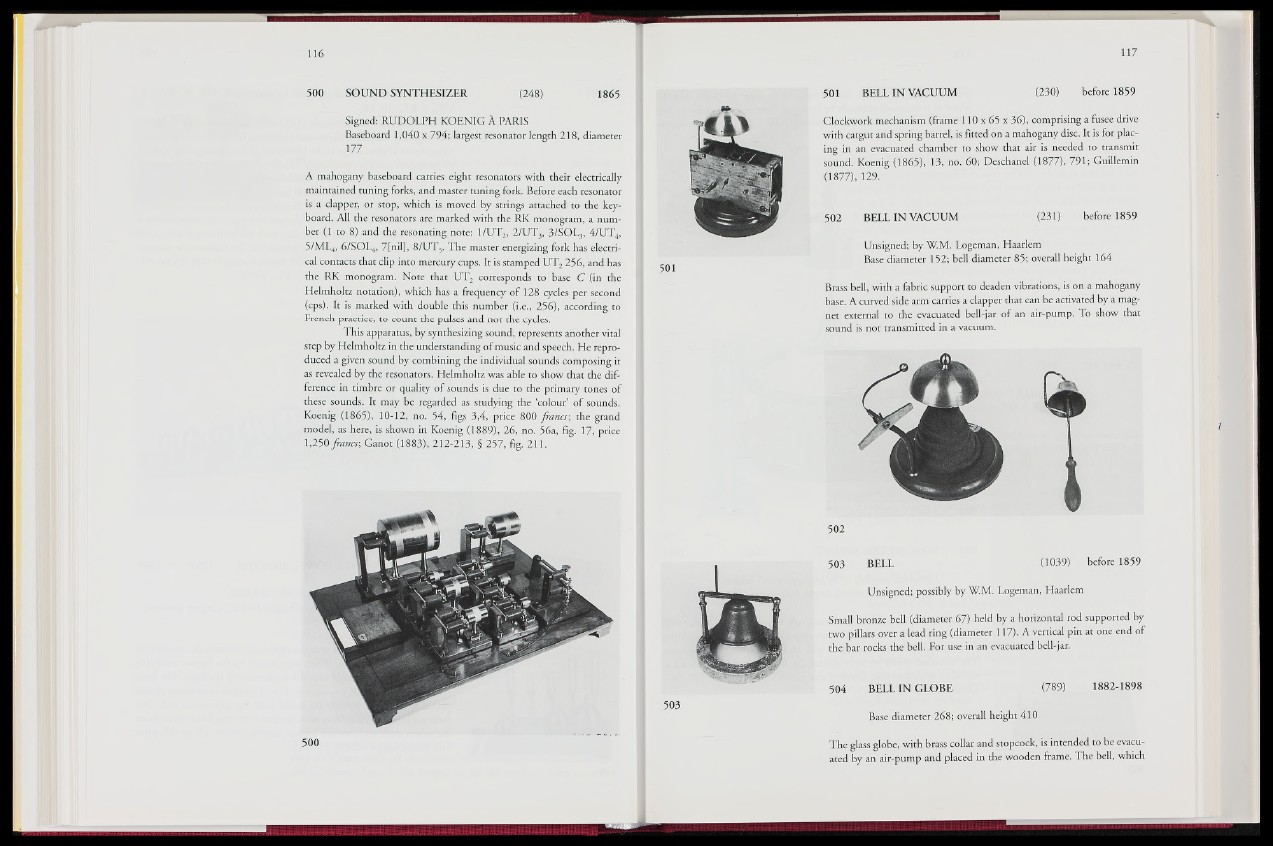
500 SOUND SYNTHESIZER (248) 1865
Signed: RUDOLPH KOENIG A PARIS
Baseboard 1,040 x 794; largest resonator length 218, diameter
lltlW:
A mahogany baseboard carries eight resonators with their electrically
maintained tuning forks, and master tuning fork. Before each resonator
is a clapper, or stop, which is moved by strings attached to the keyboard.
All the resonators are marked with the RK monogram, a number
(1 to 8) and the resonating note: 1/UT2, 2/UT3, 3/SOL3, 4/UT4,
5/ML4, 6/SOL4, 7 [nil], 8/UT5. The master energizing fork has electrical
contacts that clip into mercury cups. It is stamped UT2 256, and has
the RK monogram. Note that UT2 corresponds to base C (in the
Helmholtz notation), which has a frequency of 128 cycles per second
(cps). It is marked with double this number (i.e., 256), according to
French practice, to count the pulses and not the cycles.
This apparatus, by synthesizing sound, represents another vital
step by Helmholtz in the understanding of music and speech. He reproduced
a given sound by combining the individual sounds composing it
as revealed by the resonators. Helmholtz was able to show that the difference
in timbre or quality of sounds is due to the primary tones of
these sounds. It may be regarded as studying the colour of sounds.
Koenig (1865), 10-12, no. 54, figs 3,4, price 800 francs; the grand
model, as here, is shown in Koenig (1889), 26, no. 56a, fig. 17, price
1,250 francs; Ganot (1883), 212-213, § 257, fig. 211.
501 BELL IN VACUUM (230) before 1859
Clockwork mechanism (frame 110 x 65 x 36), comprising a fosee drive
with catgut and spring barrel, is fitted on a mahogany disc. It is for placing
in an evacuated chamber to show that air is needed to transmit
sound. Koenig (1865), 13, no. 60; Deschanel (1877), 791; Guillemin
(1877), 129.
502 BELL IN VACUUM (231)- before 1859
Unsigned; by W.M. Logeman, Haarlem
Base diameter 152; bell diameter 85; overall height 164
Brass bell, with a fabric support to deaden vibrations, is on a mahogany
base. A curved side arm carries a clapper that can be activated by a magnet
external to the evacuated bell-jar of an air-pump. To show that
sound is not transmitted in a vacuum.
503 BELL (1039) before 1859
Unsigned; possibly by W.M. Logeman, Haarlem
Small b ro n z e il« (diameter 67) held by a horizontal rod supported by
two pillars over a lead ring (diameter 117). A vertical pin at one end of
the bar rocks the bell. For use in an evacuated bell-jar.
504 BELL IN GLOBE . (789) 1882-1898
Base diameter 268; overall height 410
The glass globe, with brass collar and stopcock, is intended to be evacuated
by an air-pump and placed in the wooden frame. The bell, which